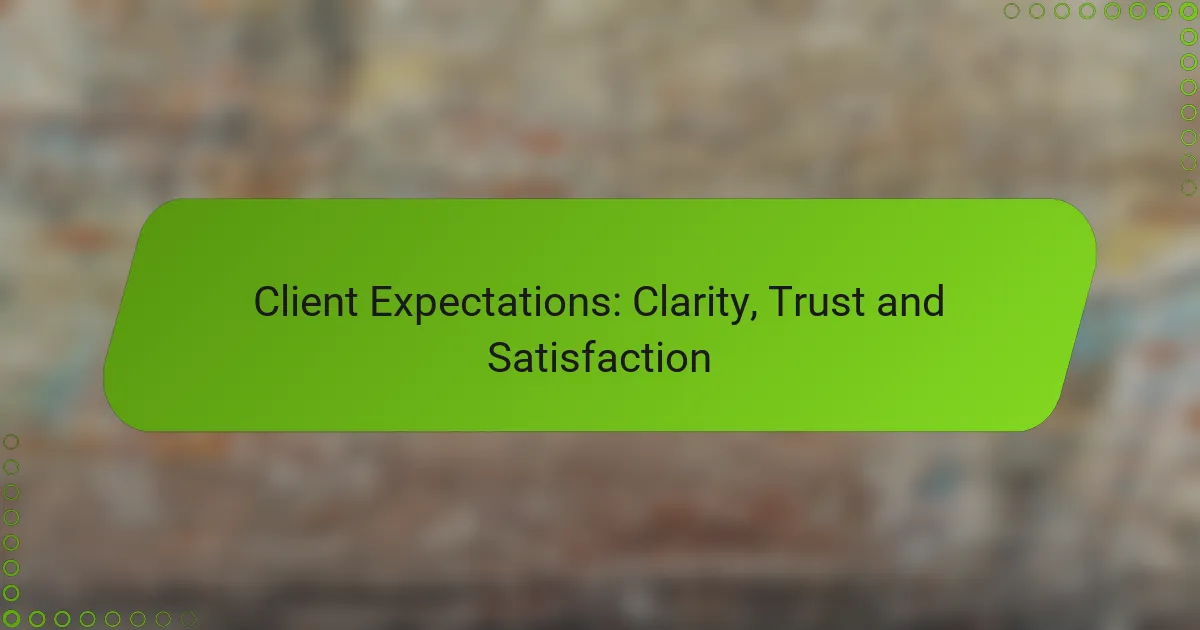In today’s competitive landscape, managing client expectations is crucial for fostering successful partnerships. By clearly defining project scopes, timelines, and deliverables, businesses can establish a foundation of trust and satisfaction. Transparent communication and responsiveness not only enhance client experiences but also pave the way for long-term loyalty and collaboration.

How to Set Clear Client Expectations?
Setting clear client expectations involves defining the project’s scope, establishing effective communication, outlining deliverables and timelines, and utilizing onboarding processes. This clarity fosters trust and satisfaction, ensuring both parties are aligned throughout the project.
Define project scope
Defining the project scope is crucial for managing client expectations. It involves detailing what is included in the project and what is not, which helps prevent scope creep. Clearly outline the objectives, tasks, and boundaries of the project to ensure everyone understands the goals.
Consider using a project scope statement or a visual diagram to illustrate the key components. This can include specific features, functionalities, and any limitations. Regularly revisiting the scope with the client can help maintain alignment and address any changes promptly.
Establish communication channels
Establishing effective communication channels is essential for keeping clients informed and engaged. Choose platforms that suit both your team and the client, such as email, project management tools, or instant messaging apps. Consistent updates and check-ins can help build trust and clarify any uncertainties.
Set expectations for response times and availability to avoid misunderstandings. For instance, agree on how often you will provide updates and when clients can expect to hear back from you. This proactive approach can significantly enhance the client experience.
Outline deliverables and timelines
Clearly outlining deliverables and timelines helps clients understand what to expect and when. Create a detailed schedule that includes key milestones and deadlines for each deliverable. This transparency allows clients to plan accordingly and reduces anxiety about project progress.
Consider using a Gantt chart or a simple timeline to visualize the project schedule. Regularly review and adjust these timelines as needed, and communicate any changes promptly to maintain trust and satisfaction.
Utilize client onboarding processes
Utilizing client onboarding processes can streamline the initial stages of a project and set a positive tone. A well-structured onboarding process introduces clients to your workflow, tools, and team members, ensuring they feel comfortable and informed from the start.
Include essential information such as project goals, timelines, and communication protocols in your onboarding materials. A checklist can be helpful to ensure all necessary steps are completed, such as signing contracts, providing necessary documents, and scheduling kickoff meetings. This organized approach fosters clarity and builds a strong foundation for the project.

What Builds Trust with Clients?
Building trust with clients hinges on transparency, reliability, and effective communication. When clients feel informed and valued, their confidence in your services grows, leading to long-term relationships.
Transparent pricing models
Transparent pricing models are crucial for establishing trust. Clients appreciate knowing exactly what they are paying for without hidden fees or unexpected charges. Clearly outline your pricing structure, including any potential additional costs, to foster openness.
Consider offering tiered pricing options or packages that cater to different budgets. This allows clients to choose a plan that best fits their needs while understanding the value they receive at each level.
Consistent follow-ups
Consistent follow-ups demonstrate your commitment to client satisfaction and engagement. Regular communication helps clients feel valued and informed about their projects. Schedule follow-ups after key milestones or meetings to check in and address any concerns.
Utilize tools like CRM software to automate reminders for follow-ups, ensuring no client feels neglected. A simple email or call can reinforce your dedication to their success and strengthen the relationship.
Showcase client testimonials
Showcasing client testimonials builds credibility and trust. Positive feedback from previous clients serves as social proof of your reliability and effectiveness. Feature testimonials prominently on your website and marketing materials to highlight your successes.
Encourage satisfied clients to share their experiences through reviews or case studies. This not only enhances your reputation but also provides potential clients with relatable insights into your services.
Deliver on promises
Delivering on promises is fundamental to maintaining trust with clients. Meeting deadlines and fulfilling commitments reinforces your reliability and professionalism. Always set realistic expectations and communicate proactively if any challenges arise.
Implement project management tools to track progress and ensure timely delivery. When clients see that you consistently meet your promises, their trust in your services will deepen, leading to repeat business and referrals.

How to Ensure Client Satisfaction?
Ensuring client satisfaction involves actively engaging with clients, addressing their needs, and fostering a trusting relationship. By focusing on clear communication and responsiveness, businesses can enhance client experiences and build long-term loyalty.
Solicit regular feedback
Regular feedback is crucial for understanding client expectations and areas for improvement. Implementing surveys, follow-up calls, or feedback forms can help gather insights on client satisfaction levels and service quality.
Consider using a mix of quantitative and qualitative questions to capture comprehensive feedback. Aim to conduct these assessments quarterly or after significant project milestones to stay aligned with client needs.
Provide exceptional customer service
Exceptional customer service is a cornerstone of client satisfaction. Train your team to be responsive, empathetic, and knowledgeable, ensuring they can address client inquiries promptly and effectively.
Establish clear communication channels, such as dedicated support lines or chat options, to facilitate quick resolutions. Aim for response times within a few hours for urgent issues to demonstrate commitment to client care.
Offer personalized solutions
Personalized solutions cater to the unique needs of each client, enhancing their overall experience. Take the time to understand their specific requirements and preferences, which can lead to tailored offerings that resonate more deeply.
Utilize client data and previous interactions to inform your approach. For example, if a client frequently requests certain services, proactively suggesting related options can show attentiveness and build trust.
Implement a satisfaction guarantee
A satisfaction guarantee reassures clients that their needs will be met and fosters trust. Clearly outline the terms of your guarantee, including what clients can expect if they are not satisfied with the service provided.
Consider offering a money-back guarantee or a redo of services within a specified timeframe. This not only mitigates client risk but also encourages them to engage with your services confidently, knowing they have recourse if expectations are not met.

What Criteria Should Be Used for Client Evaluation?
Client evaluation should focus on communication effectiveness, project outcomes, and client retention rates. These criteria help assess how well client expectations are met and identify areas for improvement.
Assess communication effectiveness
Effective communication is crucial for understanding client needs and expectations. Evaluate how clearly and promptly information is shared, including responses to inquiries and updates on project progress.
Consider using client feedback surveys to gauge satisfaction with communication. Aim for a response time of no more than 24 hours for inquiries to maintain trust and clarity.
Evaluate project outcomes
Project outcomes should align with the initial goals set during client onboarding. Assess whether deliverables meet quality standards and deadlines, and whether they fulfill the client’s objectives.
Utilize metrics such as on-time delivery rates and quality assessments to measure success. A good practice is to conduct a post-project review to discuss outcomes and gather insights for future projects.
Measure client retention rates
Client retention rates indicate overall satisfaction and loyalty. Track how many clients return for additional services or renew contracts over a specific period, typically annually.
A retention rate above 70% is generally considered strong in many industries. Implement strategies like loyalty programs or regular check-ins to enhance client relationships and encourage repeat business.

How to Handle Client Complaints Effectively?
Handling client complaints effectively requires a structured approach that prioritizes understanding, communication, and resolution. By addressing issues promptly and transparently, you can build trust and enhance client satisfaction.
Listen Actively
Active listening is crucial when addressing client complaints. It involves giving your full attention to the client, acknowledging their concerns, and asking clarifying questions to ensure you understand the issue fully. This approach helps clients feel valued and heard.
To practice active listening, maintain eye contact, nod in agreement, and summarize their points back to them. This not only confirms your understanding but also reassures the client that their concerns are taken seriously.
Respond Promptly
Timely responses to complaints can significantly impact client satisfaction. Aim to acknowledge the complaint within a few hours and provide a detailed response within one to two business days. This shows clients that you prioritize their issues and are committed to resolving them.
Consider setting up an automated response for initial acknowledgments, followed by a personalized message once you have more information. This keeps clients informed while you investigate their concerns.
Offer Solutions
Once you understand the complaint, focus on offering practical solutions. Tailor your response to the specific issue raised, whether it involves a refund, replacement, or service adjustment. Providing options can empower clients and enhance their satisfaction.
For instance, if a client is unhappy with a product, you might offer a full refund or a replacement item. Clearly outline the steps they need to take to resolve the issue, ensuring the process is as straightforward as possible.
Follow Up
After resolving a complaint, follow up with the client to ensure they are satisfied with the solution. This step reinforces your commitment to their satisfaction and allows you to gather feedback on your handling of the situation.
A simple email or phone call a few days after the resolution can go a long way in rebuilding trust. Ask if they have any further concerns or if there’s anything else you can assist them with, demonstrating that you value their ongoing relationship.
